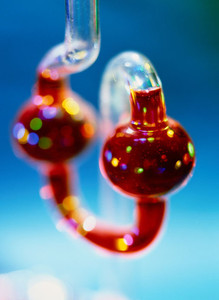During a presentation given by Ms Melody Sauerborn (TNO Triskelion, The Netherlands) at an international conference on biowaivers and biosimilars, held in the US in September 2012, the immunological aspects of formation of anti-drug antibodies against aggregated protein drugs were discussed [1].
Protein aggregation and the generation of immune responses
Biosimilars/Research
|
Posted 14/03/2014
 2
Post your comment
2
Post your comment

The role of aggregation in the generation of immune responses was emphasized in the context of the fact that this phenomenon is especially important for the comparison of biosimilars and reference biologicals that may have slightly different rates of aggregation leading to possible differences in the initiation of an anti-drug immune response.
Protein aggregation is a biological phenomenon in which mis-folded proteins aggregate, i.e. accumulate and clump together, either intra- or extra-cellularly. There is evidence that such protein aggregation can result in enhanced immunogenicity; however, the precise immunological and biochemical mechanisms responsible are poorly defined.
The aggregation of biosimilar low molecular weight heparins (LMWHs) has been shown to be different to their equivalent reference biological when using a platelet aggregation assay [2]. This raises concerns about the possibility for immunogenicity reactions in LMWHs, as well as in other biologicals. One example of such unwanted immunogenicity was when cases of pure red cell aplasia (PRCA) were caused after the formulation of an originator product Eprex (epoetin alfa) was changed [3].
The conclusion of the presentation was that the method used to measure the rate of immunogenicity and the immunogenic potential of biosimilars and reference biologicals can significantly impact the comparability of the two molecules, and therefore great care must be taken in the development and execution of assays to measure immunogenicity.
Related articles
Immunogenicity testing in biosimilars
Analysis of carbohydrate containing biosimilars
Bioanalytical challenges in the development of biosimilars
References
1. Colletti KS. Conference Report: Bioanalysis-related topics presented at the International Conference and Exhibition on Biowaivers and Biosimilars. Bioanalysis 2013;5(5):529-31.
2. GaBI Online - Generics and Biosimilars Initiative. Immunogenicity of biosimilar low molecular weight heparins [www.gabionline.net]. Mol, Belgium: Pro Pharma Communications International; [cited 2014 Mar 14]. Available from: www.gabionline.net/Biosimilars/Research/Immunogenicity-of-biosimilar-low-molecular-weight-heparins
3. GaBI Online - Generics and Biosimilars Initiative. Epoetin alfa and pure red cell aplasia [www.gabionline.net]. Mol, Belgium: Pro Pharma Communications International; [cited 2014 Mar 14]. Available from: www.gabionline.net/Biosimilars/Research/Epoetin-alfa-and-pure-red-cell-aplasia
Permission granted to reproduce for personal and non-commercial use only. All other reproduction, copy or reprinting of all or part of any ‘Content’ found on this website is strictly prohibited without the prior consent of the publisher. Contact the publisher to obtain permission before redistributing.
Copyright – Unless otherwise stated all contents of this website are © 2014 Pro Pharma Communications International. All Rights Reserved.
Posted 05/08/2014 by Justyna K, GaBI Online Editorial Office
Response to 'Protein aggregation and the generation of immune responses'
Dear Mr Bohrer, Thank you for your comments and for pointing out the specific details. Upon checking, we agree that the original report contained some misleading information. As such, we have updated the article with the current information. We appreciate very much your kind feedback, and please continue with your valuable comments to GaBI Online. Thank you and regards, Justyna
Posted 15/03/2014 by Bob Bohrer
Protein aggregation and the generation of immune responses
The article is helpful, but in discussion it characterizes Eprex (epoetin alpha) as a LMWH (low molecular weight heparin). Eprex is a cytokine protein and NOT an LMWH. It was, however, involved in the immunogenicity problem referenced in the article.
General
Samsung Bioepis wins Pyzchiva case; Regeneron patent rulings threaten foreign biosimilars
Chinese biosimilars go global: growth, partnerships, and challenges
What is the future for the US biosimilar interchangeability designation

Biosimilars/Research Posted 05/06/2025
Biosimilar clinical efficacy studies: are they still necessary?

Biosimilars/Research Posted 27/05/2025
The best selling biotechnology drugs of 2008: the next biosimilars targets








Post your comment